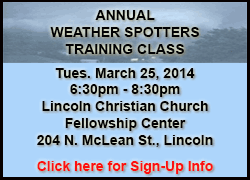|
NWS alerts that are used to warn of severe weather, flood and
tornado hazards include the following: — Tells when and where severe
thunderstorms are likely to occur. Watch the sky and stay tuned
to NOAA Weather Radio, commercial radio or television for
information.
Severe
thunderstorm warning — Issued when severe weather has been
reported by spotters or indicated by radar. Warnings indicate
imminent danger to life and property to those in the path of the
storm. Gather family members and pets and take shelter
immediately. Have your emergency supply kit ready and continue
to monitor your NOAA Weather Radio, commercial radio or
television for more information.
Tornado watch
— Tornadoes are possible. Remain alert for approaching storms.
Watch the sky and stay tuned to NOAA Weather Radio, commercial
radio or television for information.
Tornado warning
— A tornado has been sighted or indicated by weather radar. Take
shelter immediately.

-
Flood watch —
Flooding is possible. Tune in to NOAA Weather Radio, commercial
radio or television for information.
-
Flash flood watch
— Flash flooding is possible. Be prepared to move to higher
ground; listen to NOAA Weather Radio, commercial radio or
television for information.
-
Flood warning
— Flooding is occurring or will occur soon. If advised to
evacuate, do so immediately.
-
Flash flood warning — A flash flood
is occurring. Seek higher ground on foot immediately. Do not
attempt to drive into flooded areas or walk through moving
water.
[to top of second column] |

Be aware that sirens are designed as an outdoor warning
system only to alert those who are outside that something
dangerous is approaching. A NOAA Weather Radio can be critical
to ensure you're alerted to dangerous weather when indoors.
"The National Weather Service provides accurate and timely
warnings and advisories, but they are only effective if people
receive them, understand their risk and take the correct action to
protect themselves," said Teri Schwein, acting director of the
Central Region of the National Weather Service. "Everyone should
make time to prepare themselves before severe weather strikes by
signing up for local weather emergency alerts, understanding NWS
warnings and developing an emergency action plan."
"Wireless Emergency Alerts (WEAs) sent to a mobile device are
also used to notify individuals of potentially dangerous weather
conditions," said Andrew Velasquez, regional administrator for FEMA
Region V. "If you have a WEA-capable phone and your wireless carrier
participates in the program, this will enable you to be immediately
aware of potentially life-threatening emergencies."
For more information about WEA, visit
www.fema.gov/wireless-emergency-alerts, and for valuable tips to
help prepare for severe weather, visit
www.ready.gov/severe-weather or download the free FEMA app,
available for Android, Apple or BlackBerry devices.
[Text from file received from
FEMA
Region V]FEMA's
mission is to support citizens and first responders to ensure that
as a nation we work together to build, sustain and improve our
capability to prepare for, protect against, respond to, recover from
and mitigate all hazards. Follow FEMA online at
twitter.com/femaregion5,
facebook.com/fema and
youtube.com/fema. Also,
follow administrator Craig Fugate's activities at
twitter.com/craigatfema.
The social media links provided are for reference only. |